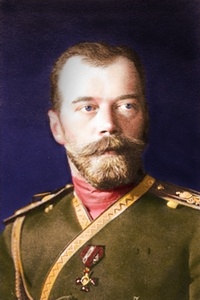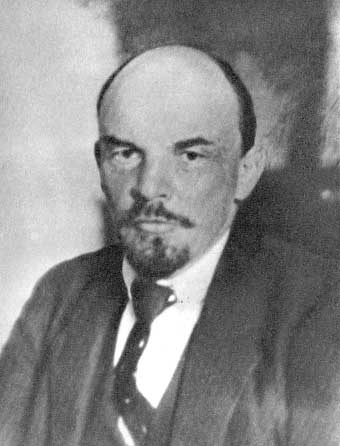|
|
|
|
|
|
|
|
|
|
|
|
|
The Russian Revolution of 1917 involved the collapse of
an empire under Tsar Nicholas II and the rise of Marxian socialism under
Lenin and his Bolsheviks. It sparked the beginning of a new era in Russia
that had effects on countries around the world.
In the years leading up to the Russian Revolution of 1917, the country had a succession of wars. These were, The Crimean War (1854-56), The Russo-Turkish War (1877-78), The Russo-Japanese War (1904-1905), and World War I (1914-18). All of these required a lot from the state, including tax dollars and manpower. Russia suffered defeat in all, except against Turkey. This series of war caused great discontent among the people and caused suffering in the country's economy and government.
Along with these wars, there were three major parties that contributed to the cause of the revolution. First, there were the peasants, who maintained the majority of the population in Russia. They were excessively poor and could barely escape famine from harvest to harvest. The population boom in Russia from 1867-1896 was felt most drastically by the peasants. The increase of 30 million people in less than 30 years was too great that the land to the peasants' disposal did not increase sufficiently. The government tried to help, but war took precedence. Second, there was a rise of the industrial working class. These workers were employed in the mines, factories and workshops of the major cities. They suffered low wages, poor housing and many accidents. Again, the government tried to help by passing factory acts to restrict the amount of hours one could work. However, their efforts were at too small a scale to have any real effect. As a result, there were many strikes and constant conflicts between the workers and the police. Lastly, the tsar of Russia was the cause of much disapproval. Tsar Nicholas II was much more interested in his family life, than matters of the state. He had an obsession with retaining all his privileges and the belief that he was chosen by God to rule. Also, he didn't understand the forces of industrialization and nationalism that were growing throughout Russia. His disregard for the struggles of the people led them to lose faith in him and the long-standing tradition of autocracy. The people were not content and were ready to revolt. They just needed a good reason and a strong leader.
Research Report
The Russian Revolution of 1917 was one of the most significant events
in the 20th century. It completely changed the government and
outlook on life in the very large country of Russia. The events of the
revolution were a direct result of the growing conflict in World War I,
but the significance of an empire collapsing and a people rising up extends
beyond the war effort.

In 1914, Russia entered the war with much vigor. However, their enthusiasm was not enough to sustain them and the army suffered many casualties and loss of artillery supplies. Russia lacked mobilization skills to counter its losses, but more importantly it lacked good leadership. Tsar Nicholas II (r. 1894 – 1917) had complete control over the bureaucracy and the army. He refused to share his power and the masses began to question his leadership. In the summer of 1915, the Duma (parliament), demanded a government with democratic values and which responded to the people’s needs. Later that year, however, Nicholas dissolved the Duma and went to the war front. His leaving was detrimental.
The government was taken over by Tsarina Alexandra and her unique counterpart,
Rasputin. Alexandra was a very strong-willed woman, who disliked parliaments
and supported absolutism. She attempted to rule absolutely in her husband’s
absence by dismissing and electing officials on a whim. Her favorite official,
Rasputin, which means "Degenerate", was a Siberian preacher. He belonged
to a sect that mixed sexual orgies with religion and he had mysterious
healing powers. As a result of rumors of the two being lovers, Rasputin
was murdered in December 1916 by three aristocrats. In the cities, food
shortages continued to rise and the morale of the people fell. Riots broke
out on March 8, 1917 in the city of Petrograd. (The Julian calendar that
Russia used at the time was 13 days behind the western, Gregorian, calendar.
Therefore, some date the riot on February 24th.) It was started
by women demanding more bread, but eventually spread to other industries
and throughout the city. Even the soldiers on the front joined in the revolution.
The Duma set up a provisional government on March 12, 1917 and a few days
later the tsar stepped down.

The provisional government established a liberal program of various rights. These included freedom of speech, religion and assembly; equality before the law; and the right of unions to organize and strike. The leaders of this new established government, including Alexander Kerensky, were still opposed to social revolution and saw the continuation of the war effort as a national duty. The government had to compete for power with the Petrograd Soviet of Workers’ and Soldiers’ Deputies. This group scrupulously watched the provisional government and even made decrees of their own. One of which took away the authority of the officers and placed it with elected committees. This lead to a collapse of army discipline. Later that year, soldiers began returning home to seize some land for their families. Peasants were looting farms and having food riots because the provisional government had not overcome the problem of food supply. Anarchy was taking the place of liberty and this was the perfect situation for a radical socialist like Vladimir Ilyich Lenin to take control.
Lenin (1870-1924) was a strong supporter of Marxian socialism. He believed
that capitalism would only disappear with a revolution and this was only
possible under certain conditions. The socialism party was split between
Lenin’s, Bolsheviks, or "majority group" and the Mensheviks, or "minority
group". Lenin’s group did not stay the majority, but he kept the name and
developed a disciplined, revolutionary group. The Bolsheviks attempted
to seize power in July, but failed. Lenin fled from Petrograd and went
into hiding in Finland. The party’s popularity, however, grew tremendously
throughout the summer.
By the autumn of 1917, it was clear that the main social and economical problems that caused the uprising in March still existed. In the second half of September, there was a debate in Petrograd between the Bolsheviks and the other parties (socialists and Mensheviks). The voting figures clearly pointed towards a Bolshevik majority. Leon Trotsky was elected as chairman of the governing body. Trotsky (1879-1940) was a radical Marxist, amazing orator and huge supporter of Lenin. Outside Petrograd, the feelings of the population coincided with the Bolshevik convictions. The people wanted to see the end of Kerensky's government, the end to the war and they wanted new land distribution. Trotsky and Lenin saw the answer to all these desires in a Bolshevik seizure of power.
From Finland, Lenin urged the Bolshevik committee to plan an armed uprising. Many thought it was too premature and reckless. However, after Lenin made a trip to Petrograd incognito and they debated with them for ten hours, the Bolsheviks were convinced. Trotsky masterfully executed the revolution. He formed a military-revolutionary committee to head the arming of workers throughout Petrograd. Factory meetings were held to boost the workers' enthusiasm. Finally, on the night of November 6 (or October 26), the combined forces of the Bolshevik soldiers and workers stormed the city and seized government buildings. They went on to gain the majority in the congress and declared Lenin as their new leader.
Lenin declared an end to the fighting and made armistice proposals.
He also decreed the nationalization of land. However, he was far from solving
the problem of hunger among the people. Lenin and his Bolsheviks had increased
opposition in the next few years. Civil war broke out and external fears
persisted. Earlier in the fighting, Tsar Nicholas II and family had been
interned in the Ipatiev house, located on the Bolshevik base at Yekaterinburg.
In July 1918, the royal family was killed. They were murdered out of fear
that if they remained alive they could serve as a focus of the anti-Bolshevism
movement. By the end of 1920, when some stability did return, Russia emerged
as an entirely different country.
The events of the Russian Revolution that brought the Soviet Union about
had a deep impact on the entire world. It generated a new way of thinking
about economy, society and the government. The Bolsheviks set out to cure
Russia of all its injustices that arouse from social class differences.
They succeeded in some ways. Even still, the revolution marked the end
of a dynasty that had lasted 300 years and concluded with the seizure of
power by a small revolutionary group. The tsar was replaced with a Council
of People’s Commissars and private ownership was abolished. The Communist
movement began to grow worldwide, which frightened the capitalist world.
Although the strength of Communism did not last, because it existed at
all is proof that the Russian Revolution was a major event of the twentieth
century.
Fitzpatrick, Sheila. The Russian Revolution. New York: Oxford
University Press, 1994.
Kochan, Lionel. The Russian Revolution. New York: Wayland (Publishers)
Ltd., 1971.
Marples, David R. Lenin's Revolution: Russia, 1917-1921. London:
Pearson Education Limited, 2000.
Massie, Robert K. The Romanovs: The Final Chapter. New York:
Random House, 1995.
Shukman, Harold. The Russian Revolution. Great Britain: Guernsey
Press Company Limited, 1998.
Wade, Rex A. The Russian Revolution, 1917. New York: Cambridge
University Press, 2000.
http://www.mmmfiles.com/20tha02.htm -- This is an essay that gives a brief overview of the Russian Revolution and explains the reasoning behind it. It also gives a great historical background.
Russian Revolution of 1917 -- A short encyclopedia article that explains the events of the revolution. Also contains links to other sites with more information.
http://www.geocities.com/CapitolHill/Senate/5471/ -- An excellent site for pictures of the people involved.
http://www.fordham.edu/halsall/mod/modsbook39.html -- "Internet Modern History Sourcebook", collection of government documents and some of Lenin's writings.
http://www.encyclopedia.com/articles/11250.html -- Some short articles that trace the Revolution from the causes up to the period of civil war.
http://www.eurohist.com/the_russian_revolution.ht -- A great source for explanation of the causes of the revolution, especially about The Crimean War.